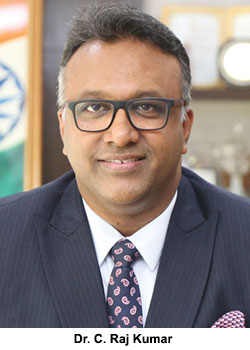 A polymath alumnus of Madras, Delhi, Hong Kong, Oxford and Harvard universities, Dr. C. Raj Kumar is founding vice chancellor of the O.P. Jindal Global University, Sonipat, Haryana (JGU, estb.2009). JGU is ranked among India’s Top 5 private universities by EducationWorld, and India’s #1 private university in the World University Rankings 2021 league table of the London-based Quacquarelli Symonds (QS).
A polymath alumnus of Madras, Delhi, Hong Kong, Oxford and Harvard universities, Dr. C. Raj Kumar is founding vice chancellor of the O.P. Jindal Global University, Sonipat, Haryana (JGU, estb.2009). JGU is ranked among India’s Top 5 private universities by EducationWorld, and India’s #1 private university in the World University Rankings 2021 league table of the London-based Quacquarelli Symonds (QS).
How satisfied are you with NEP 2020’s proposals for higher education?
NEP 2020 is an outstanding policy document and has the vision and potential to revolutionise higher education in India, if executed as proposed. The policy document is wide-ranging covering pedagogy and curriculum, online learning, multidisciplinary education and research, internationalisation, digitisation, professional and vocational education, teacher education, student experiences, regulatory frameworks, institutional governance, diversity and other crucial facets of higher education. I especially appreciate the balance this policy proposes to achieve between quality and equity of access to higher education, and its emphasis on liberal arts and research.
What’s your comment on compulsory transformation of all HEIs (higher education institutions) into large multidisciplinary universities and colleges as mandated by NEP 2020?
Clustering HEIs into large multidisciplinary universities will enable delivery of holistic education to students, and lead to better utilisation of available resources. To implement this proposal, it’s important for HEIs to expand into multidisciplinary universities, or cluster and consolidate themselves into viable universities. Established universities could mentor colleges to manage the transformation. Therefore, regulatory agencies should give them time, support and resources to expand their range of disciplines or cluster with neighbouring institutions.
NEP 2020 has set a target of India achieving GER (gross enrolment ratio) in higher education of 50 percent by 2035. This could result in quality dilution…
If we are able to successfully achieve the consolidation of HEIs and establish one HEI per district as proposed by NEP 2020, we should achieve this GER target. Other reforms such as multiple entry and exit options, award of vocational degrees and providing higher education in local languages will also translate into higher enrolment. However, there’s also need to focus on investing resources in faculty expansion and development, so that increased student intake doesn’t compromise quality or negatively impact teacher pupil ratios. A collaborative effort is needed between government, regulators, universities and private philanthropists to ensure quality is not diluted. My belief is that the use of technology, introduction of multidisciplinary education, curriculum and pedagogical reforms will ensure balance between quality and equitable access.
The advantages of multiple entry and exit points in higher education study programmes.
This will provide students flexibility and enable them to complete their higher education if they experience circumstantial constraints, and also reduce drop-out rates. However, implementing this NEP 2020 recommendation will require a balance of creative thinking and practical utility to develop curriculums for well-structured 1/2/3/4 year undergraduate programmes. It is critical to devise curriculums that equip students with sufficient skills to find employment when they exit the system. Also, a robust system will be needed to manage the proposed Academic Bank of Credits, and maintain reliable records of students entering and exiting study programmes.
What do you see as the major policy implementation roadblocks in higher education?
For NEP 2020 to be implemented in timely and effective manner, the entire higher education ecosystem needs to commit itself to building trust between all stakeholders including HEIs, government authorities and regulatory bodies. To introduce greater transparency and speed up decision-making processes, HEIs need academic freedom, institutional autonomy, and operational independence.Also, supervisory and regulatory agencies should empower and grant greater academic freedom to autonomous HEIs and Institutes of Eminence to improve their global standing. Moreover, government agencies and regulatory bodies should consider engaging HEIs in participative consultation, especially when creating or modifying regulations impacting them.
Is there any important reform in higher education which NEP 2020 has not addressed?
Though NEP 2020 has done a thorough job of covering a wide range of issues, I would have liked the policy
to pay more attention to:
• The role of private higher education institutions, including private universities. This is particularly critical given that over 70 percent of students are in private HEIs.
• Ways and means to incentivise philanthropists to promote not-forprofit private HEIs, including generous tax benefits and other incentives for donors.
• The importance of Indian universities rising in QS and THE World University Rankings league tables.
• The special role that Institutes of Eminence need to play in building world-class universities.
Read: Implementing NEP 2020: Expert advice for central government
Recommended: EW Interview: Prof. Dr. C. Raj Kumar, VC, O.P. Jindal Global University


























